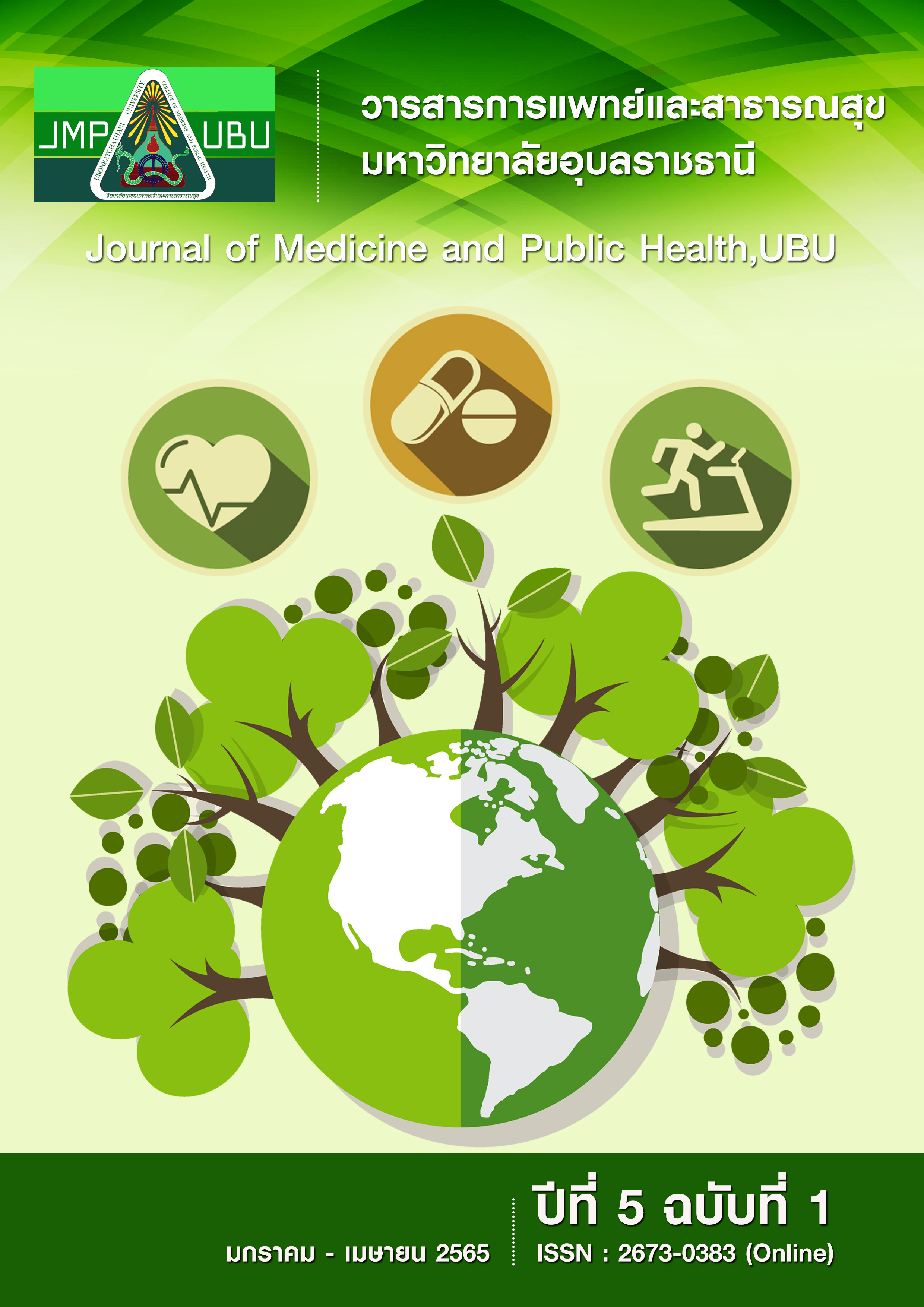การถอดบทเรียนตำบลจัดการคุณภาพชีวิตต้นแบบ ภาคตะวันออกเฉียงเหนือ ประเทศไทย
คำสำคัญ:
การจัดการคุณภาพชีวิต, ตำบลต้นแบบ, การถอดบทเรียนบทคัดย่อ
การศึกษาครั้งนี้เป็นการวิจัยเชิงคุณภาพ มีวัตถุประสงค์เพื่อถอดบทเรียนตำบลต้นแบบจัดการคุณภาพชีวิต ภาคตะวันออกเฉียงเหนือของประเทศไทย พื้นที่ในการศึกษาคัดเลือกจากตำบลที่ผ่านเกณฑ์ตำบลจัดการคุณภาพชีวิตที่มีผลงานดีเด่นระดับเขตบริการสุขภาพที่ 7, 8, 9 และ 10 จำนวน 4 ตำบล โดยมีผู้ให้ข้อมูลสำคัญ ได้แก่ ผู้นำชุมชน ภาคีเครือข่ายองค์กรชุมชน อาสาสมัครสาธารณสุขประจำหมู่บ้าน (อสม.) และประชาชนในชุมชน ระยะเวลาทำการวิจัยตั้งแต่เดือนมกราคม-สิงหาคม พ.ศ. 2564 เครื่องมือที่ใช้ในการศึกษา ได้แก่ แบบสัมภาษณ์แบบไม่มีโครงสร้าง โดยการสัมภาษณ์เชิงลึก การสังเกตแบบมีส่วนร่วม การสนทนากลุ่ม และการวิเคราะห์เอกสาร วิเคราะห์ข้อมูลโดยการทบทวนหลังปฏิบัติงาน และการวิเคราะห์เชิงเนื้อหา โดยการนำเสนอข้อมูลในรูปแบบการพรรณนา ผลการศึกษาพบว่า ตำบลจัดการคุณภาพชีวิตต้นแบบ เกิดการพัฒนาคุณภาพชีวิตของคนในชุมชนแบบพึ่งตนเอง โดยมีปัจจัยสำคัญ ดังนี้ 1) ผู้นำชุมชน 2) การมีส่วนร่วมของภาคีเครือข่าย 3) การสนับสนุนทางสังคม 4) ธรรมนูญตำบลหรือข้อตกลงร่วมกัน 5) การประเมินกระบวนการ (TPAR) 6) ต้นทุนทางสังคม และ 7) คุณภาพชีวิต จากการถอดบทเรียนตำบลจัดการคุณภาพชีวิตต้นแบบ ทำให้เห็นแนวทางในการพัฒนาคุณภาพชีวิตของคนในชุมชนแบบพึ่งตนเองบนพื้นฐานต้นทุนทางสังคม ทรัพยากร วัฒนธรรม โดยมีผู้นำชุมชนเป็นผู้ที่มีบทบาทสำคัญในการนำพาชุมชนสู่การพัฒนา ในการศึกษาครั้งต่อไปควรศึกษารูปแบบตำบลการจัดการคุณภาพชีวิตต้นแบบ โดยการเสริมสร้างพลังภาคีเครือข่ายและการขับเคลื่อนโดยธรรมนูญตำบลให้ชุมชนมีคุณภาพชีวิตที่ดี สุขกาย สุขใจ สุขเงิน และสุขสามัคคี
Downloads
เอกสารอ้างอิง
คณะกรรมการอำนวยการจัดทำแผนพัฒนาสุขภาพแห่งชาติ ฉบับที่ 12 กระทรวงสาธารณสุข. แผนพัฒนาสุขภาพแห่งชาติ ฉบับที่ 12 (2560-2564) [อินเตอร์เน็ต]. [สืบค้นเมื่อ 30 กันยายน 2564]. แหล่งข้อมูล: https://www.ubu.ac.th/web/files_up/80f2017031913062639.pdf.
กองสนับสนุนสุขภาพภาคประชาชน กรมสนับสนุนบริการสุขภาพ. แนวทางการดำเนินงานสุขภาพภาคประชาชน ปีงบประมาณ 2563 [อินเตอร์เน็ต]. [สืบค้นเมื่อ15 สิงหาคม 2564]. แหล่งข้อมูล: http://ssj.stno.moph.go.th/wordpress/wp-content/uploads/2019.
กรมสนับสนุนบริการสุขภาพ. แนวทางการขับเคลื่อนการดำเนินงาน พชอ.ผ่านกลไกตำบลจัดการคุณภาพชีวิต “ชุมชนสร้างสุข: สุขกาย สุขใจ สุขเงิน” ปีงบประมาณ 2562 [อินเตอร์เน็ต]. [สืบค้นเมื่อ 1 ตุลาคม 2564]. แหล่งข้อมูล: http://phc.moph.go.th/www_hss/data_center/dyn_mod/po1.rar.
กองสนับสนุนสุขภาพภาคประชาชน กรมสนับสนุนบริการสุขภาพ. โครงการชุมชนสร้างสุขโดยกลไกตำบลจัดการคุณภาพชีวิต “ตำบลวิถีใหม่ ปลอดภัยโควิด 19” [อินเตอร์เน็ต]. [สืบค้นเมื่อ 15 สิงหาคม 2564]. แหล่งข้อมูล: http://phc.moph.go.th/www_hss/data_center/dyn_mod/district64.pdf.
จักรี ศรีจารุเมธีญาณ และพระถนัด วฑฺฒโน. ภาวะผู้นำกับการพัฒนาชุมชน. วารสาร มจร สังคมศาสตร์ปริทรรศน์ 2560; 6(2), 527-38.
สุพัตรา พุ่มพ่วง และสุภาภรณ์ วรอรุณ. การสร้างสุขภาพของชุมชนในจังหวัดสุพรรณบุรี : กรณีศึกษา. วารสารพยาบาลทหารบก 2555; 13(1), 66-71.
ธิติรัตน์ ราศิริ และอาจินต์ สงทับ. แนวทางการมีส่วนร่วมภาคีเครือข่ายในการส่งเสริมสุขภาพผู้สูงอายุเพื่อก้าวสู่ “ศตวรรษที่ 21”. วารสารเครือข่ายวิทยาลัยพยาบาลและการสาธารณสุขภาคใต้ 2561; 5(1), 315-28.
สมเกียรติ สุทธรัตน์. การสร้างเครือข่ายสุขภาพในชุมชนเพื่อการส่งเสริมสุขภาพจิตและป้องกันปัญหาสุขภาพจิตในผู้สูงอายุ [อินเตอร์เน็ต]. [สืบค้นเมื่อ 20 ตุลาคม 2564]. แหล่งข้อมูล: https://tci-thaijo.org/index.php/npuj/article/download/94799/87939/.
Marc Pilisuk. Delivery of social support: The Social Inoculation. American Journal of Orthopsychiatry 1982; 52(1), 20-31.
อรรถพล ศรีประภา. กระบวนการขับเคลื่อนธรรมนูญสุขภาพเฉพาะพื้นที่ ในประเด็นการส่งเสริมสุขภาพด้วยการออกกำลังกายในชุมชน ตำบลโคกกว้าง อำเภอบุ่งคล้า จังหวัดบึงกาฬ. 2558; (ปริญญาสาธารณสุข
ศาสตรมหาบัณฑิต สาขาวิชาสาธารณสุขศาสตร์). บัณฑิตวิทยาลัย: มหาวิทยาลัยมหาสารคาม.
กองสนับสนุนสุขภาพภาคประชาชน กรมสนับสนุนบริการสุขภาพ. เกณฑ์การประเมินผลตำบลจัดการสุขภาพแบบบูรณาการ ปีงบประมาณ 2561 [อินเตอร์เน็ต]. [สืบค้นเมื่อ 15 สิงหาคม 2564]. แหล่งข้อมูล: http://www.thaiphc.net/thaiphcweb/uploads/content/636/5a53331557226.pdf.
ไมตรี อินเตรียะ. ทุนทางสังคม Social Capital. วารสารนาคบุตรปริทรรศน์ 2560; 9(2), 14-25.
World Health Organization. The world health report 1998 – Life in the 21st century: a vision for all [Internet]. [Retrieved August 20, 2021]. Source: https://www.who.int/whr/1998/en/whr98_en.pdf.
Padilla GV and Grant MM. Quality of life as a cancer nursing outcome variable. ANS Adv Nurs Sci 1985; 8(1), 45-60
ดาวน์โหลด
เผยแพร่แล้ว
รูปแบบการอ้างอิง
ฉบับ
ประเภทบทความ
สัญญาอนุญาต
ลิขสิทธิ์ (c) 2022 วารสารการแพทย์และสาธารณสุข มหาวิทยาลัยอุบลราชธานี

อนุญาตภายใต้เงื่อนไข Creative Commons Attribution-NonCommercial-NoDerivatives 4.0 International License.
เนื้อหาและข้อมูลในบทความที่ลงตีพิมพ์ในวารสารการแพทย์และสาธารณสุข มหาวิทยาลัยอุบลราชธานี ถือเป็นข้อคิดเห็นและความรับผิดชอบของผู้เขียนบทความโดยตรง ซึ่งกองบรรณาธิการวารสารไม่จำเป็นต้องเห็นด้วย หรือร่วมรับผิดชอบใด ๆ
บทความ ข้อมูล เนื้อหา รูปภาพ ฯลฯ ที่ได้รับการตีพิมพ์ในวารสารการแพทย์และสาธารณสุข มหาวิทยาลัยอุบลราชธานี ถือเป็นลิขสิทธิ์ของวารสารการแพทย์และสาธารณสุข มหาวิทยาลัยอุบลราชธานี กองบรรณาธิการไม่สงวนสิทธิ์ในการคัดลอกเพื่อการพัฒนางานด้านวิชาการ แต่ต้องได้รับการอ้างอิงที่ถูกต้องเหมาะสม






